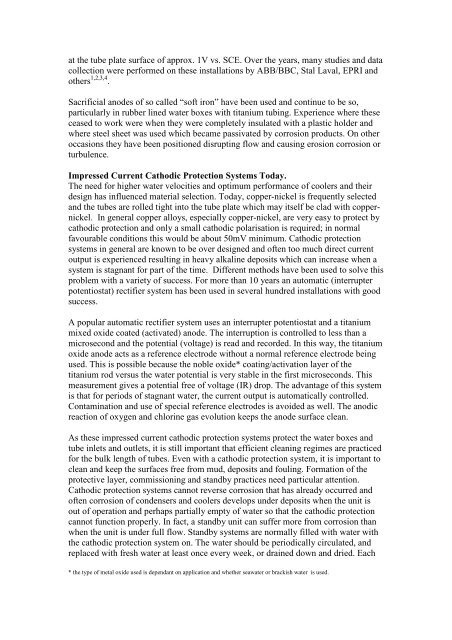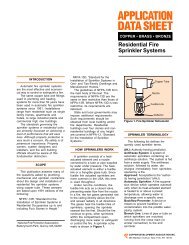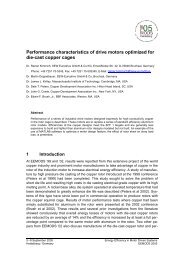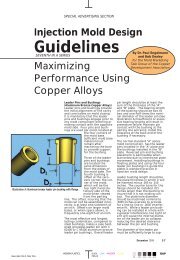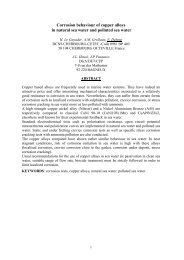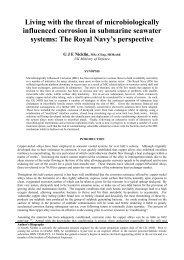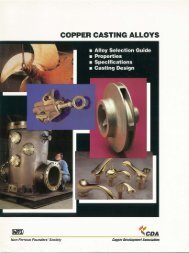Leif _rev3 - Copper Development Association
Leif _rev3 - Copper Development Association
Leif _rev3 - Copper Development Association
You also want an ePaper? Increase the reach of your titles
YUMPU automatically turns print PDFs into web optimized ePapers that Google loves.
at the tube plate surface of approx. 1V vs. SCE. Over the years, many studies and datacollection were performed on these installations by ABB/BBC, Stal Laval, EPRI andothers 1,2,3,4 .Sacrificial anodes of so called “soft iron” have been used and continue to be so,particularly in rubber lined water boxes with titanium tubing. Experience where theseceased to work were when they were completely insulated with a plastic holder andwhere steel sheet was used which became passivated by corrosion products. On otheroccasions they have been positioned disrupting flow and causing erosion corrosion orturbulence.Impressed Current Cathodic Protection Systems Today.The need for higher water velocities and optimum performance of coolers and theirdesign has influenced material selection. Today, copper-nickel is frequently selectedand the tubes are rolled tight into the tube plate which may itself be clad with coppernickel.In general copper alloys, especially copper-nickel, are very easy to protect bycathodic protection and only a small cathodic polarisation is required; in normalfavourable conditions this would be about 50mV minimum. Cathodic protectionsystems in general are known to be over designed and often too much direct currentoutput is experienced resulting in heavy alkaline deposits which can increase when asystem is stagnant for part of the time. Different methods have been used to solve thisproblem with a variety of success. For more than 10 years an automatic (interrupterpotentiostat) rectifier system has been used in several hundred installations with goodsuccess.A popular automatic rectifier system uses an interrupter potentiostat and a titaniummixed oxide coated (activated) anode. The interruption is controlled to less than amicrosecond and the potential (voltage) is read and recorded. In this way, the titaniumoxide anode acts as a reference electrode without a normal reference electrode beingused. This is possible because the noble oxide* coating/activation layer of thetitanium rod versus the water potential is very stable in the first microseconds. Thismeasurement gives a potential free of voltage (IR) drop. The advantage of this systemis that for periods of stagnant water, the current output is automatically controlled.Contamination and use of special reference electrodes is avoided as well. The anodicreaction of oxygen and chlorine gas evolution keeps the anode surface clean.As these impressed current cathodic protection systems protect the water boxes andtube inlets and outlets, it is still important that efficient cleaning regimes are practicedfor the bulk length of tubes. Even with a cathodic protection system, it is important toclean and keep the surfaces free from mud, deposits and fouling. Formation of theprotective layer, commissioning and standby practices need particular attention.Cathodic protection systems cannot reverse corrosion that has already occurred andoften corrosion of condensers and coolers develops under deposits when the unit isout of operation and perhaps partially empty of water so that the cathodic protectioncannot function properly. In fact, a standby unit can suffer more from corrosion thanwhen the unit is under full flow. Standby systems are normally filled with water withthe cathodic protection system on. The water should be periodically circulated, andreplaced with fresh water at least once every week, or drained down and dried. Each* the type of metal oxide used is dependant on application and whether seawater or brackish water is used.


